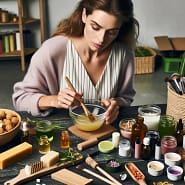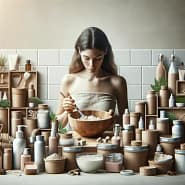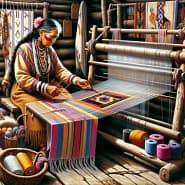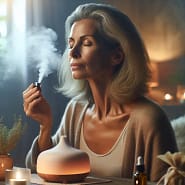Introduction: The benefits of choosing organic lipstick
Have you ever paused to consider the ingredients in your everyday lipstick or wondered how they may affect your health? In the world of cosmetics, organic lipstick is becoming a beloved trend due to its numerous benefits in comparison to conventional lipsticks. This ultimate guide will explore these benefits, and show you how to create your very own organic lipstick from the comforts of your home.
Why Choose Organic Lipstick?
⦁ Health-conscious: Organic lipsticks are made from natural and non-toxic substances, reducing exposure to synthetic ingredients and chemicals that could harm the body.
⦁ Nourishing: Organic lipsticks often contain natural oils and butter, which moisturize and nourish your lips, preventing them from drying or cracking.
⦁ Eco-friendly: Many organic lipsticks are packaged in eco-friendly and biodegradable materials, contributing to environmental sustainability.
⦁ Vivid and long-lasting: Contrary to a common misconception, organic lipsticks provide vibrant color and long-lasting effects just as effectively as their synthetic counterparts.
Crafting your own organic lipstick: Aside from just purchasing, why not take a step further and create your own personalized lipstick? Come on this journey as we dive into eliminating harmful substances, sourcing sustainable, natural ingredients and, of course, creating your unique organic lipstick.
From understanding the potentially harmful ingredients in conventional lipsticks to ensuring sustainability and ethical practices in homemade beauty products, this guide covers every detail you’d want to know. Get ready to embrace the journey to natural beauty with your own organic lipstick. Let’s get started, shall we?
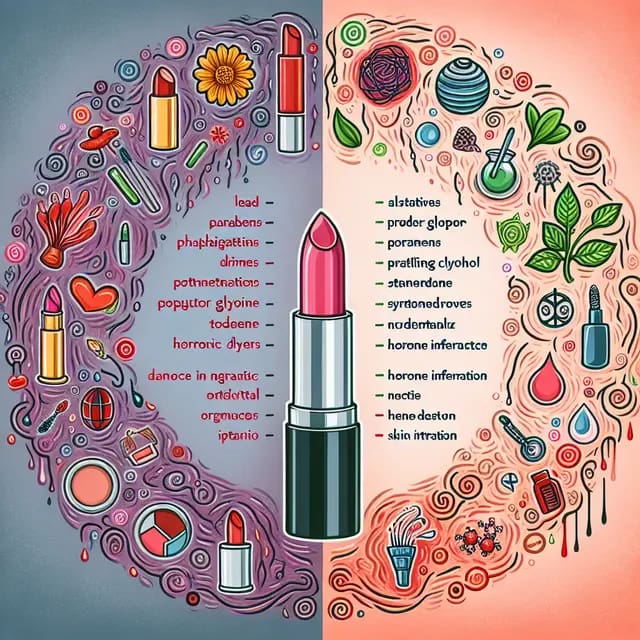
Understanding the harmful ingredients in conventional lipsticks
As you start your journey towards crafting your own organic lipstick, it’s important to understand why you’re making this move. Conventional lipsticks, while convenient and varied, contain a cocktail of harmful ingredients that are not good for your health nor the environment. Let’s take a closer look.
1. Lead: A heavy metal that is toxic when ingested or inhaled. It can damage the nervous system and cause brain disorders. Maybe the most concerning fact is that lead is often found in high concentration in conventional lipstick.
2. Parabens: Common in many cosmetic products. Its role is to prevent the growth of bacteria and prolong the shelf life of the products. Understandably desirable features, however, parabens are known to interfere with the body’s hormone function, specifically mimicking estrogen, which leads to an increased risk of breast cancer and reproductive issues.
3. Phthalates: Found in scented products to enhance their fragrance, this chemical is linked to an increased risk of breast cancer, early breast development in girls, and reproductive birth defects in males and females.
4. Propylene glycol: This petroleum-based substance is used to retain moisture. Though it’s generally recognized as safe by the FDA, it can cause skin irritation and allergic reactions.
- 5. Synthetic dyes: Used to achieve the range of colors available, synthetic dyes may contain heavy metals and can cause skin irritation.
- 6. Toluene: Commonly found in nail polish, but also in some lipsticks, toluene is a potent neurotoxicant that can cause systemic toxicity.
Switching to organic lipstick not only helps you dodge these dangerous substances, it also gives the assurance that you’re using safe, natural ingredients on your skin. Proceed to the next section for a detailed guide on how to mix up your own lip colors using healthy, eco-friendly components.

Essential Tools and Ingredients for Making Organic Lipstick at Home
Creating your organic lipstick at home is not only fun and exciting, but also assures you that your lipstick is free from harmful chemicals. In this section, we will discuss all the essential tools and ingredients you need to start your journey to natural beauty. Here are the must-haves from our Ultimate Guide to Crafting Your Own Organic Lipstick:
Essential Tools
- Double Boiler: This essential kitchen gadget is perfect for melting your base ingredients evenly and securely without overcooking them.
- Spatula or Spoon: To mix your ingredients thoroughly.
- Lipstick Molds: These reusable molds determine the size and shape of your lipstick.
- Disposable Pipettes: These help you distribute the lipstick mixture into the molds cleanly and precisely.
- Containers: You’ll need lipstick tubes or small jars to store your finished product.
Essential Ingredients
Creating a homemade organic lipstick primarily involves three base ingredients – a wax, an oil, and a colorant. Here’s what you’ll need:
- Organic Beeswax: This is the primary component of your lipstick base. It gives the lipstick its solid form and allows it to stay on your lips.
- Carrier Oils: Oils such as organic coconut oil, jojoba oil, and castor oil are excellent options. The oil makes the lipstick easy to apply and provides nourishment for your lips.
- Natural Colorants: Options include beetroot powder for a red hue, cocoa powder for a brown color, and turmeric for an orange tone. Also, you might want to consider mineral-based micas and oxides for a broader color range.
Now, with your tools and ingredients prepared, you are one step closer to crafting your very own organic lipstick at home. In the next section, we will provide a step-by-step guide on how to mix these elements together and mold your first lipstick. The power to create a lipstick that suits your skin type, style, and preference will soon be in your hands!
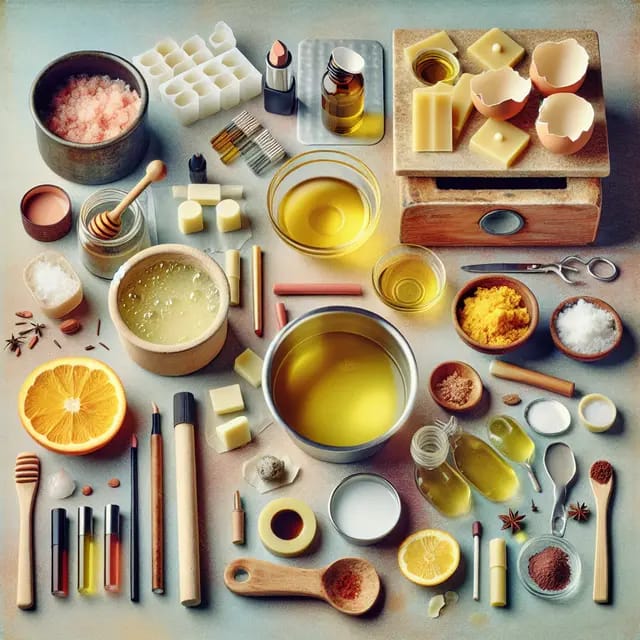
Step-by-step guide on how to craft your own organic lipstick
Embracing all-natural beauty has never been easier with the DIY trend for organic lipstick. Dipping your toes into this liberating process allows you to take full control of the ingredients you use, ensuring the safety and effectiveness of your beauty product. Follow our step-by-step guide, designed to help you craft your organic lipstick with ease.
Ingredients and Materials
- 2 teaspoons organic beeswax or organic carnauba wax for vegan option
- 1 teaspoon organic shea butter or organic cocoa butter
- 1 teaspoon organic coconut oil or sweet almond oil
- 1/4 teaspoon organic pigment powder, such as beetroot powder for reds or cinnamon for browns
- 1 drop essential oil for flavor (optional)
- Lipstick mold or cleaned out chapstick tubes
- Double boiler or glass bowl and pot
Procedure
- In your double boiler or glass bowl over simmering water, melt your wax, shea butter or cocoa butter, and oil.
- Once fully melted, carefully remove the mixture from the heat.
- Sieve in your chosen organic pigment, mixing well. Adjust the color as needed.
- If desired, add a drop of essential oil for an added natural flavor.
- Pour the mixture into your mold or cleaned out chapstick tubes. Let it cool and solidify.
Creating your own organic lipstick nourishes your lips with the purest materials while giving you the freedom to customize the ideal shade. It’s a fun and empowering journey, allowing you to craft beauty products that align with your style, health values, and ethical practices.
As we delve further into this Ultimate Guide to Crafting Your Own Organic Lipstick, you’ll learn how to tailor your blend, store your homemade lipstick and the significance of making sustainable choices. Stay tuned!
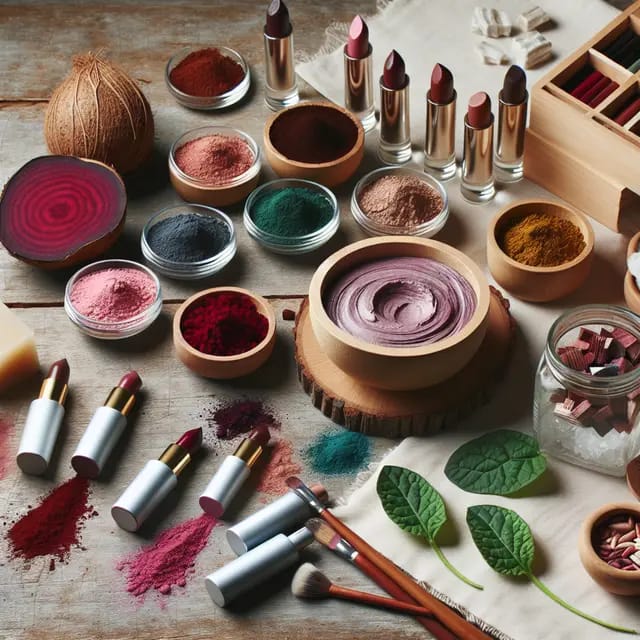
Tips for Customizing the Color and Texture of Your Organic Lipstick
Looking for ways to add a personal touch to your homemade organic lipstick? You’re in the right place! Not only does making your own lipstick empower you to avoid harmful ingredients, but it also gives you the freedom to create a unique product that perfectly matches your preferences.
Color Customization
Choosing the perfect shade for your organic lipstick is essential; it’s all a matter of knowing which natural pigments to mix and match. Here are some tips:
- Beetroot Powder: An excellent option for creating shades of pink and red.
- Cocoa Powder: Ideal for crafting natural, nude shades.
- Spirulina Powder: Opt for this if you’re aiming for unusual or bold lipstick colors like deep green.
Texture Customization
Just as the color, the texture of your lipstick is crucial for the look and feel you want to achieve. Here’s how you can vary the texture:
- For a creamy texture: Increase the quantity of oils in your lipstick recipe. Oils like coconut, jojoba, or almond oil work best.
- For a matte finish: Add more beeswax or any other natural wax. It gives a denser and non-shiny look to your lip color.
- For a glossy or shimmery effect: Mica powders are your solution. They come in several colors to add both shimmer and pigment.
Remember, when making homemade organic lipstick, experimentation is key. Don’t be afraid to play around with different pigments and textures until you find the perfect combination that works for you. Happy crafting!
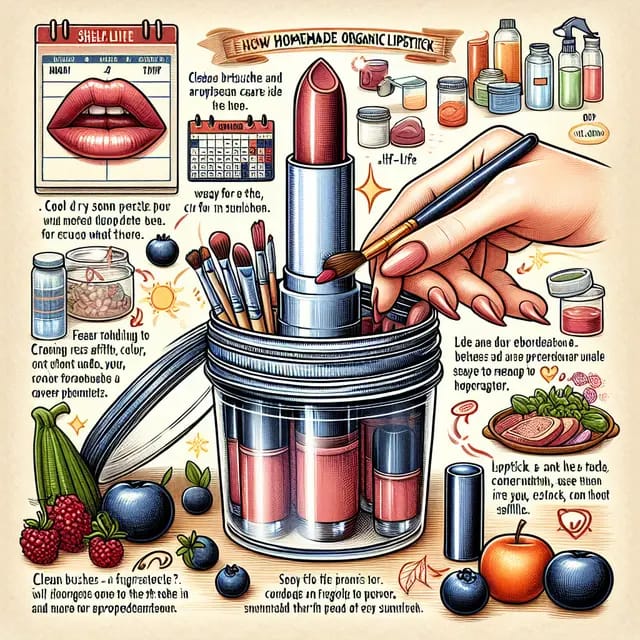
How to Store and Properly Care for Your Homemade Organic Lipstick
Maintaining the freshness and longevity of your homemade organic lipstick is critical to enjoying its benefits for an extended period. Proper storage and care are crucial factors in preserving the quality and color vibrancy of your organic lipstick, as well as preventing bacteria growth. Follow these proven strategies to keep your organic lipstick in the best possible condition:
Bullet Points:
- Keep it in a Cool, Dry Place: High temperatures can cause your homemade organic lipstick to melt or change its texture. To prevent this, store it in a cool, dry environment away from direct sunlight.
- Store it Properly: Use clean, airtight containers to store your lipstick. Keeping it sealed tightly prevents air exposure that could lead to spoilage.
- Use Clean Tools: Always use clean brushes or fingers when applying your organic lipstick. This minimizes the chances of transferring bacteria that could compromise its quality.
- Refrigerate if Needed: To extend shelf life, especially in warmer climates, you might consider refrigerating your lipstick. Before doing so, be sure to place it in an airtight container to safeguard it from food smells.
- Observe the Shelf Life: Homemade organic lipstick may not contain preservatives, which shortens its shelf life. Typically, it should be usable for up to a year, but it’s important to observe any changes in smell or texture as these are indicators it’s no longer safe to use.
Remember, despite the appeal and benefits of organic lipstick, improper storage and care can diminish its quality. By following these measures, you can enjoy your homemade organic lipstick for the longest time possible, experiencing the full benefits of its organic and natural ingredients. Stay tuned to follow us on a journey to a more sustainable and ethical beauty regimen, highlighting the importance of these practices in homemade beauty products.
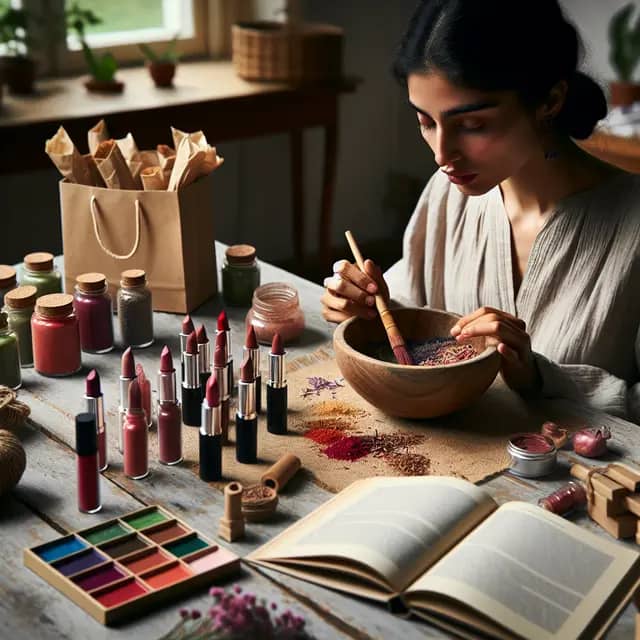
The Importance of Sustainability and Ethical Practices in Homemade Beauty Products
As we delve into the benefits and nuances of crafting your own organic lipstick, it’s paramount to consider the broader implications of our lifestyle choices. The beauty industry is notorious for its harmful environmental practices and unethical labor conditions. But by making your own organic lipstick, you’re taking a stand against these systemic issues. Let’s talk about sustainability and ethical practices in homemade beauty products, and why they should be a fundamental part of your journey to natural beauty.
- Reduced Environmental Impact: Conventional beauty products often contribute to environmental degradation due to excessive plastic packaging and the use of non-biodegradable ingredients. By creating your own organic lipstick, you carefully select each element right from the ingredients to the packaging, helping to reduce plastic waste and lessen your environmental footprint.
- Support for Ethically-Sourced Ingredients: Many ingredients found in conventional lipsticks are sourced through harmful practices such as child labor and unfair trade. On the other hand, ingredients for organic lipsticks can be sourced ethically and sustainably. This means that when you craft your own organic lipstick, you’re supporting a network of producers who are being treated fairly.
- Knowledge is Power: By crafting your own organic lipstick, you’re able to understand each ingredient’s purpose. This level of transparency is often lacking in the beauty industry. In doing this, you’re not only empowering yourself, but also encouraging transparency within the industry.
- Natural Lifestyle Advocacy: Lastly, by creating your own beauty products, you’re advocating for a healthier, more natural lifestyle. By choosing not to patronize conventional beauty brands that disregard sustainability and ethical practices, you’re casting your vote for more responsible businesses.
Your journey with organic lipstick is a step towards a more ethical and sustainable future that takes responsibility for our environment and respects the rights of workers all over the world. Remember, the choices you make today will significantly shape our tomorrow.
In our next section, we’ll wrap up with final thoughts on embracing the journey to natural beauty with your homemade organic lipstick.
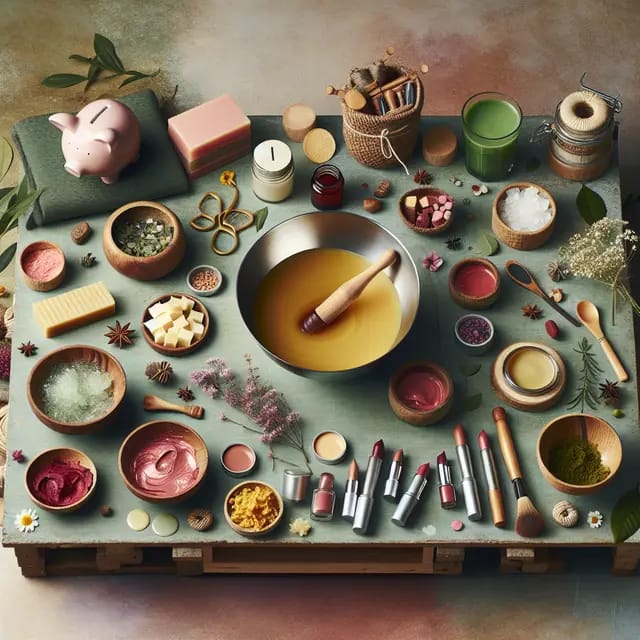
Conclusion: Embracing the Journey to Natural Beauty with Your Own Organic Lipstick
In this transformative journey to natural beauty, the power is truly in your hands. Crafting your own organic lipstick not only empowers you to express your creativity and individuality, but also ensures that you are taking care of your overall wellness.
- Sustainability and Ethics: As we have discussed above, making your own organic lipstick goes beyond superficial beauty. It’s an ethical practice that promotes sustainability and reduces our carbon footprint. By using environmentally friendly ingredients and minimal plastic packaging, you actively play a role in preserving our planet.
- Health and Wellness: Using natural and organic ingredients in your lipstick ensures that you are not risking your health by exposing your lips and body to harmful chemicals. As your lips absorb anything you put on them, it’s important to opt for organic and non-toxic materials. This leads to a healthier body inside and out.
- Customization: Making your own organic lipstick allows you the freedom to create colors, textures, and finishes that cater to your personal preference. Whether you want a subtle nude shade for everyday use or a bold red for special occasions, the possibilities are limitless!
- Financial Savings: Not only does crafting your own organic lipstick contribute to healthier living and environmental protection, but it can also lead to financial savings. Expensive designer lipsticks often contain the same basic ingredients that you can purchase at a fraction of the price.
When you take up the challenge of making your own organic lipstick, you are making a commitment to yourself and the planet. Your lips will look vibrant and beautiful, your body will thank you, and our Earth will breathe a sigh of relief.
Remember, beauty and health are inseparable. The next time you swipe on your lipstick, make sure it’s the organic one you’ve crafted lovingly. Embrace the journey of natural beauty with your own organic lipstick. Keep loving, keep crafting!
